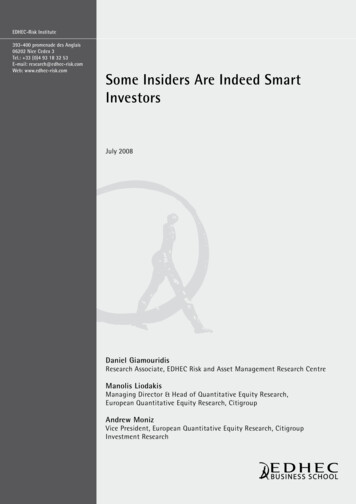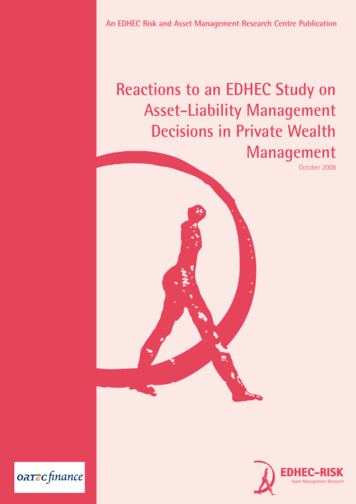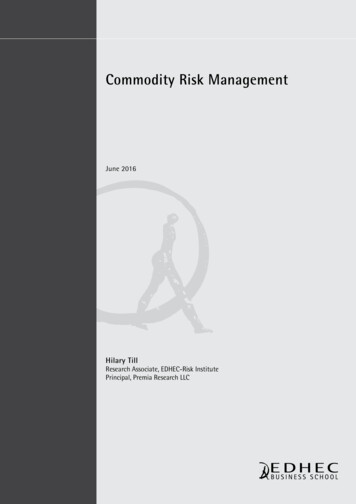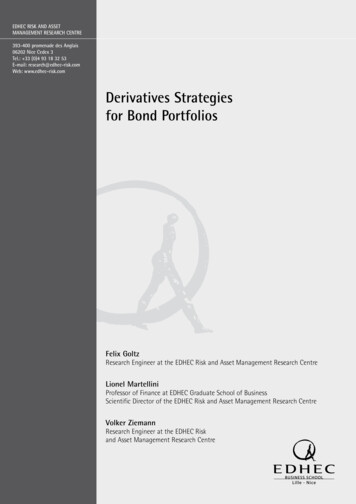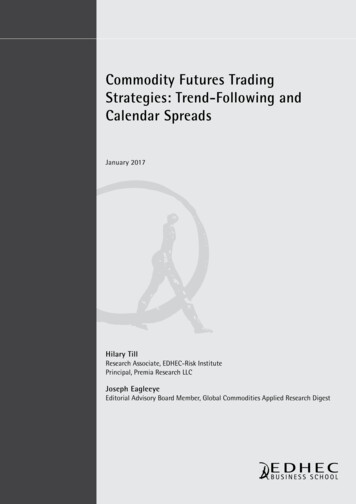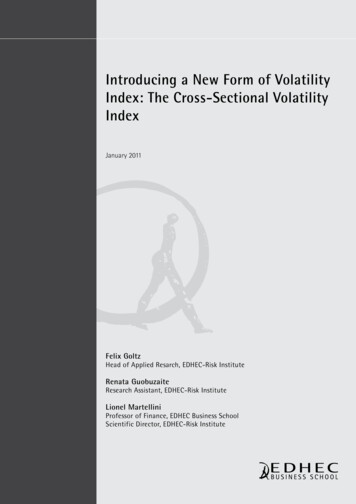
Transcription
Introducing a New Form of VolatilityIndex: The Cross-Sectional VolatilityIndexJanuary 2011Felix GoltzHead of Applied Resarch, EDHEC-Risk InstituteRenata GuobuzaiteResearch Assistant, EDHEC-Risk InstituteLionel MartelliniProfessor of Finance, EDHEC Business SchoolScientific Director, EDHEC-Risk Institute
Executive SummaryWe introduce a new form of volatility index, the cross-sectional volatility index. Throughformal central limit arguments, we show that the cross-sectional dispersion of stockreturns can be regarded as an efficient estimator for the average idiosyncratic volatility ofstocks within the universe under consideration. Among the key advantages of the crosssectional volatility index measure over currently available measures are its observability atany frequency, its model-free nature, and its availability for every region, sector, and styleof the world equity markets, without the need to resort to any auxiliary option market.We also provide some interpretation of the cross-sectional volatility index as a proxy foraggregate economic uncertainty, which suggests that the cross-sectional volatility index shouldbe intimately related to option-based implied volatility measures. We confirm this intuitionby reporting high correlation between the VIX index and the corresponding cross-sectionalvolatility index based on the S&P500 universe. We also find the high correlation between thetwo volatility measures to be robust with respect to changes in sample period, changes in marketconditions, and changes in the region under consideration. Overall, these results suggest that thecross-sectional volatility index is intimately related to other volatility measures where and whensuch measures are available, and that it can be used as a reliable proxy for volatility when suchmeasures are not available.EDHEC is one of the top five business schools in France. Its reputation is built on the high qualityof its faculty and the privileged relationship with professionals that the school has cultivatedsince its establishment in 1906. EDHEC Business School has decided to draw on its extensiveknowledge of the professional environment and has therefore focused its research on themes thatsatisfy the needs of professionals.2EDHEC pursues an active research policy in the field of finance. EDHEC-Risk Institute carries outnumerous research programmes in the areas of asset allocation and risk management in both thetraditional and alternative investment universes.Copyright 2012 EDHEC
1. IntroductionRecent market turmoil, as well as the presence of ever stricter regulatory constraints, has ledinvestors and asset managers to monitor with increased scrutiny the volatility and downside riskof their equity holdings. In this context, market participants have shown an increasing interestin volatility indices, which are not only heavily used as sentiment indicators, but also serve asunderlyings for a number of derivatives contracts that can be used for obtaining long or shortexposure to volatility.While their existence is critical to allow investors to measure and/or trade in volatility, currentvolatility indices, suffer from a number of drawbacks. In particular, they are based not on actualstock index returns but on auxiliary option markets. As a result, the volatility estimates theyprovide tend to be polluted by option market factors that have little to do with the underlyingstock or stock index returns. Besides, and perhaps more importantly, such measures can only madeavailable only on those rare occasions when liquid option markets exist for the given universeunder consideration. As a result, very few volatility indices are available, for example, for Asianmarkets (they have been introduced—recently—only in Japan and Korea) or emerging marketsbeyond Asia (they have been introduced—recently—only in Mexico and India). Similarly, when itcomes to developed equity markets, volatility indices, when they exist, are available only at thebroad market level, so no information is currently available regarding volatility for specific sectorsor styles for a given region of the world.To address these concerns, we introduce a new form of volatility index, the cross-sectional volatilityindex. Through formal central limit arguments, we show that the cross-sectional variance of stockreturns can be regarded as an efficient estimator for the average idiosyncratic variance of stockswithin the universe under consideration. This measure of idiosyncratic risk is found to be highlycorrelated to standard measures of systematic risk when they exist, which further justifies its usein the context of equity volatility measurement. Key advantages of this measure over currentlyavailable measures such as sample-dependent historical volatility measures or option-basedimplied volatility measures are: its observability at any frequency, its model-free nature, and itsavailability for every region, sector, and style of the world equity markets, without the need toresort to any auxiliary option market.The reminder of this note is structured as follows. In section 2, we review the basic definitionsof volatility, emphasizing the key distinction between historical and implied volatility measures,and also introduce volatility indices. In section 3, we review the motives for trading in volatility,and also the instruments that have been made available for obtaining access to volatility as aninvestable asset class. In section 4, we introduce a new form of volatility index, which is meantto alleviate existing concerns over currently available volatility indices, and we document theproperties of a suitably designed cross-sectional dispersion measure as a model-free unbiasedand efficient estimate for specific volatility. In section 5, we provide some interpretation of thecross-sectional volatility index as a proxy for aggregate economic uncertainty, which suggeststhat the correlation between systematic volatility and average idiosyncratic volatility should behigh, which we confirm empirically. Finally, section 6 concludes.2. Volatility and Volatility IndicesVolatility is a statistical measure of the dispersion of returns for a given security or market index.In other words, volatility refers to the amount of uncertainty or risk about the size of changesin an underlying security or index value. Higher volatility means that the underlying value canpotentially be spread out over a larger range of values, signaling higher risk for investors holdingthe security or index. Indeed, high volatility means that the price of the security can changedramatically in either direction over a given interval of time. Lower volatility means that a security3
or index value does not fluctuate dramatically, but changes in value at a steadier pace over aperiod of time.2.1. Historical versus Implicit VolatilityWhile volatility is unambiguously formally defined as the standard deviation or variance ofreturns from a given stock or market index, a key distinction exists between two different kindsof volatility measures, namely historical volatility measures and implicit volatility measures.Historical volatility measuresHistorical volatility measures are obtained by estimating the standard deviation of returns from apast sample of equity returns. One advantage about these measures is that they can be estimateddirectly from time-series of individual stock or stock index returns. One drawback of thesemeasures is that they are not directly observable, and are dependent on a sample of past returns,which makes historical volatility estimates backward-looking measures of current volatility.Besides, historical volatility measures are artificially smooth, in that tomorrow’s estimate forhistorical volatility will only differ from today’s estimate for historical volatility only by a singledata point in a rolling-window analysis. More forward-looking estimates for historical volatilityare available through GARCH-type models, which make it possible to put more weight on morerecent observations, but the sample-dependency and artificial smoothing problems remainunsolved.Implied volatility measuresMore recently, implicit volatility estimates have been obtained from option prices. Indeed,volatility is a key variable in option pricing formulas, showing the extent to which the return ofthe underlying asset will fluctuate between now and the option expiration date. One advantageof these measures is that they are more forward-looking than historical volatility measures sincethey reflect market’s expectations about future volatility. One drawback is that they are basednot on actual stock index returns but on auxiliary option markets. As a result, the volatilityestimate is polluted by any factor impacting supply and demand in option markets that havelittle to do with the underlying stock or stock index returns. Besides, such measures can only bemade available in those rare cases when there are liquid option markets for the given universeunder consideration.2.2. Systematic versus Specific VolatilityRegardless of the method used in estimating volatility, another key distinction exists betweensystematic and specific volatility. For any given stock, total volatility can be decomposed intosystematic volatility, driven by the stock exposure with respect to systematic risk factors, andspecific volatility, which is driven by the uncertainty impacting a particular company.The recent financial literature has paid considerable attention to idiosyncratic volatility. Campbellet al. (2001) and Malkiel and Xu (2002) document that idiosyncratic volatility increased overtime, while Brandt et al. (2009) show that this trend completely reversed itself by 2007, fallingbelow pre-1990s levels, and suggest that the increase in idiosyncratic volatility through the1990s was not a time trend but rather an "episodic phenomenon". Bekaert et al. (2008) confirmthat there is no trend either for the United States or for other developed countries. A secondfact about idiosyncratic volatility is also a bone of contention. Goyal and Santa-Clara (2003)posit that idiosyncratic volatility has forecasting power for future excess returns, while Bali et al.(2005) and Wei and Zhang (2005) find that the positive relationship is not robust to the samplechosen.While representing two different underlying risk measures, one expects systematic and averagespecific volatility risk indicators to be highly correlated, since they both reflect the aggregate4
uncertainty faced by investors at a given point in time regarding economic fundamentals (seesection 5.1).In what follows, we confirm this intuition and find high correlation between the VIX index, ameasure of systematic risk based on option prices, and a model-free measure for specific risk,which we introduce in this note (see section 5.2). This high correlation is found to be robust todifferent regions and time-periods, and remains stable across market conditions.2.3. Volatility IndicesBecause information about changes in volatility is of a critical importance to market participants,a number of initiatives have been launched to make volatility measures available to investors inform of volatility indices, which are designed to track the aggregate volatility of an asset market.Such indices are typically calculated based on option prices, and as such are based on implicit asopposed to actual volatility measures.Volatility indices can now be found on such major stock indices as the S&P 500, EURO STOXX50, DAX, Dow Jones Industrial Average and lately (November 2010) the Nikkei 225. The mostpopular volatility index is the VIX, which is built from prices of equity index options on theS&P 500. The index was introduced by the options exchange CBOE in 1993 and was originallydesigned to measure the market’s expectation of thirty-day volatility implied by prices of at-themoney S&P 100 index options. The implied volatility was based on the Black-Scholes model. Tenyears later, CBOE, together with Goldman Sachs, updated the VIX methodology to reflect a newway to measure expected volatility. The implied volatility is now derived from the implied riskneutral distribution that can be extracted from call and put options with different strike prices.This volatility is model-free: rather than assuming that Black-Scholes holds, the only necessaryassumption is that of an absence of arbitrage opportunities.Table 1: Volatility indices currently available and their underlying indicesIndexTickerUnderlyingIndex ProviderQQVQQQAMEXCBOE Volatility Index VIXSPXCBOECBOE DJIA Volatility IndexVXDDJXCBOECBOE NASDAQ-100 Volatility IndexVXNNDXCBOECBOE Russell 2000 Volatility IndexRVXRUTCBOECBOE S&P 100 Volatility IndexVXOOEXCBOECBOE S&P 500 3-Month Volatility IndexVXVSPXCBOECBOE VIX Premium Strategy IndexVPDVIXCBOECBOE Capped VIX Premium Strategy IndexVPNVIXCBOECBOE Crude Oil Volatility IndexOVXUSOCBOECBOE Gold Volatility IndexGVZGLDCBOEAMEX Volatility IndexCBOE EuroCurrency Volatility IndexEVZFXECBOEAEX VolatilityVAEXAEXEuronextBEL 20 VolatilityVBELBEL 20EuronextCAC 40 VolatilityVCACCAC 40EuronextFTSE 100 VolatilityVFTSEFTSE 100EuronextDAX VolatilityVDAX-NEWDAXDeutsche Borse AGSMI VolatilityVSMISMISIX Swiss Exchange AGVSTOXXEURO STOXX 50STOXX LimitedVNKYNIKKEI 225Nikkei Inc.EURO STOXX 50 VolatilityNIKKEI Volatility IndexIndia NSE VIXINVIXNNIFTY 50India NSEKOSPI 200 Volatility IndexVKOSPIKOSPI 200Korea ExchangeMexico Volatility IndexVIMEXIPCMexDer5
Other exchanges have developed volatility indices that are similar in methodology to thoseprovided by the CBOE (see table 1 for the list of currently available volatility indices). For example,Euronext has developed volatility indices on major equity indices like the AEX, BEL20 and CAC40.Volatility indices on the DAX and SMI indices are also developed by the respective exchanges.The volatility indices are typically computed directly by the options exchange. The notableexception is the VSTOXX which indicates the volatility index based on Dow Jones EURO STOXX50 options prices and is computed by STOXX, the index provider, rather than by an optionsexchange. Volatility indices typically use options with a short time period to expiry. They thusindicate market expectations over, e.g., the next month. Some indices also exist for different timehorizons. For the VSTOXX for example, calculations of eight sub-indices are done for 1, 2, 3, 6, 9,12, 18, and 24 months to expiry.3. Volatility as an Asset ClassRecent market turbulence, as well as the presence of ever stricter regulatory constraints, has ledinvestors and asset managers to monitor with increased scrutiny the volatility and downside riskof their equity holdings. In this context, investors have shown an increased interest in regardingvolatility as an asset class that can be traded, as opposed to a mere statistical indicator measuringstock return uncertainty.3.1. Motives for Trading VolatilityOne of the main motivations for trading in volatility is to diversify equity risk through a longimplied volatility exposure (see Hill (2004) or Szado (2009) for recent references). A key point tonote is that volatility of equity returns and equity returns tend to move in opposite directions,i.e., they are strongly negatively correlated. In addition, negative correlation and high volatilityare particularly pronounced in stock market downturns, offering protection against stockmarket losses when it is needed the most and when other forms of diversification are not veryeffective.One possible explanation for the negative correlation of equity volatility to the equity marketis the “leverage effect” (Black (1976), Christie (1982), Schwert (1989)): a decrease (respectively,an increase) in equity prices increases (respectively, decreases) the company’s leverage, therebyincreasing (respectively, decreasing) the risk to equity holders and increasing (respectively,decreasing) equity volatility. Another alternative explanation (French et al. (1987), Bekaert et Wu(2000), Wu (2001), Kim et al. (2004)) is the "volatility feedback effect": assuming that volatilityis incorporated in stock prices, a positive volatility shock increases the future required return onequity and stock prices are expected to fall simultaneously.The presence of sensible economic reasons that explain the inverse relationship between equityreturn and volatility is a comforting indication of the robustness of the diversification benefitsto be expected, which stands in contrast with the well-known lack of robustness of portfoliodiversification within the equity universe, where diversification is known to fail precisely when itis most needed because of the convergence of all correlations to one in periods of high marketturbulence.Of course, it should be expected that the risk diversification benefits of long volatility exposuremay come at a cost. Recent academic research has found that there is a positive risk premium overtime to being short volatility or conversely, that there is a negative risk premium to being longvolatility. Because of the negative correlation between market index returns and market indexvolatility, buyers of options may be willing to pay a premium because a long position in volatilityhelps hedge market-wide risk (Bakshi and Kapadia (2003)). In other words, because volatility6
is negatively correlated with the returns to equities, investors are willing to pay a premium tohold this asset. In a recent paper, Carr and Wu (2010) find that the negative correlation betweenstock index returns and the return variance generates a strongly negative beta, but this negativebeta explains only a small portion of the negative variance risk premiums. Other risk factorsidentified by the recent literature, such as size, book-to-market, and momentum, cannot explainthe strongly negative variance risk premiums, either, and they conclude that the majority of themarket variance risk premium is generated by an independent variance risk factor.Other motives for trading in volatility include speculative, arbitrage and hedging demands. Directional speculative bets on volatility changes, implemented by going long volatility exposurewhen volatility is expected to rise and going short volatility exposure when volatility is expectedto fall (see Dash (2005) or Jacob (2009)). Non-directional speculative arbitrage bets, so as to benefit from mean-reversion to morenormal levels in a number of key spreads such as implied volatility versus historical volatility,three-month implied volatility vs. one-month implied volatility, etc. Volatility exposure hedging by hedge funds and mutual funds that are often implicitly shortvolatility. In particular, benchmarked equity fund managers are short volatility because portfoliotracking error and rebalancing costs increase with an increase in the volatility of equity markets(Hill (2004)).Obviously, the ability for market participants to implement trades on volatility depends on theavailability of instruments that can be used to make volatility indices investable quantities. Thisis what we turn to next.3.2. Instruments for Trading VolatilitySince volatility is the key determinant of option prices, trading in options is one possible wayto get volatility exposure, but this is not a clean bet on volatility alone: while option prices aresensitive to volatility, they are not sensitive only to volatility because of non-trivial exposure tochanges in the value of the underlying asset .n this context, derivatives instruments on volatilityare becoming more popular. With these instruments the investors can have a pure play onvolatility and can implement their views more precisely.In particular, investors can invest in volatility products though exchange-traded futures andoptions on the volatility indices. Also, other products on volatility are available like exchangetraded notes and OTC variance swaps. Table 2 shows the products currently available on volatilityindices.Table 2: Options and futures on volatility indicesIndexTickerInstitution (Owner)Futures TickerOptions on FuturesCBOE Volatility Index VIXCBOEVX (VIX Futures),AvailableCBOE DJIA Volatility IndexVXDCBOEDV-CBOE NASDAQ-100 Volatility IndexVXNCBOEVNAvailableCBOE Russell 2000 Volatility IndexRVXCBOEVRAvailableDAX VolatilityVDAX-NEWDeutsche Borse AGFVDX (delisted)SMI VolatilityVSMISIX Swiss Exchange AGFVSM (delisted)VSTOXXSTOXX LimitedFVSX (delisted), FVS (mini-futures)-VM (Mini-VIX Futures)EURO STOXX 50 VolatilityOverall, trading in volatility can be done through a number of alternative investment vehicles:futures on volatility indices, options on volatility indices, exchange-traded notes on volatilityindices, and variance swaps as well as forward variance swaps.7
Futures on Volatility IndicesFutures are available on four major CBOE volatility indices which track the volatility of the S&P500, NASDAQ 100, Russell 2000 and Dow Jones Industrial Average. Futures on volatility indicesfor European market are also available. But recently (July 1, 2009) some of these were delistedfrom the exchanges, including the futures on the volatility indices for the DAX, SMI, and STOXXwhich had a contract size of 1000 euros per index point. Dow Jones STOXX Limited continues tooffer mini-futures (FVS) on the volatility index (VSTOXX) for the EURO STOXX 50. Mini-futureson VSTOXX have been available since June 2, 2009, with a contract value of 100 euros per indexpoint.One of the biggest problems with volatility related products is liquidity. Most of the futureson these volatility indices have low trading volume and open interest. The most liquid are VIXfutures, which have an open interest of around 50,000 contracts and a daily volume of severalthousand contracts. The next most liquid product is the Mini-VIX futures, which has very lowopen interest ( 100s) compared to VIX futures and a low daily volume.Options on Volatility IndicesCBOE also offers options on VIX, RVX, and VXN which can be used for asymmetric exposure tovolatility in these markets. The CBOE Volatility Index Option has the largest volume and openinterest compared to other option products on volatility indices. Table 3 shows the dollar volumeof options traded each year on these instruments.Table 3: Dollar volume traded for volatility index optionsOption TypeRVX (Russell 2000 Volatility Index Options)VIX (CBOE Volatility Index)VXN (NASDAQ 100 Volatility Index Options)2009200820072006 108,980 6,693,381 6,274,162- 5,224,807,164 5,199,374,615 3,343,053,366 714,252,679 2,750 589,685 952,775-Exchange-Traded Notes (ETNs)Investors can also get exposure to VIX using ETNs. Barclays Bank PLC issues two different typesof ETNs which hold VIX future contracts. The iPath S&P 500 VIX Short-Term Futures and iPathS&P 500 VIX Mid-Term Futures provide exposure to short and medium term volatility of the S&P500.Variance Swaps and Forward-Start Variance SwapsVariance swaps and forward-start variance swaps are also used for pure exposure to eitherrealized or implied volatility. These are OTC products. Usually the maturities of these swaps aresimilar to option expiry dates so that they can be used in hedging applications for option traders.A forward-start variance swap is similar to a variance swap starting at a later date. Unlike VIXfutures, variance swaps can provide long term exposure to volatility term structures.4. Cross-Sectional Volatility Index as a New Volatility IndexBecause they play a central role as market uncertainty measures and because they are used asa basis for investable volatility products, informative and robust volatility indices are criticallyimportant to a large number of market participants.8As we have seen, existing volatility indices suffer from a number of shortcomings. On the onehand, volatility indices are not available for an extensive set of markets, because they require thepresence of a liquid option market; for example, no volatility index exists for small cap stocks,growth/value stocks, or various sectors for developed markets, and volatility indices do not existeven at the broad market level in most emerging markets. On the other hand, where and whenthey exist, implied volatility estimates are plagued by option-market problems that have little todo with underlying equity markets.
In what follows, we introduce a new set of volatility indices, which are meant to be based onobservable and model-free volatility measures, obtained using equity market data alone andavailable for all markets/sectors at all frequencies. These indices are based on the cross-sectionaldispersion of observed stock returns on a given date, a readily measurable quantity for anyequity universe. Using formal central-limit arguments, we show that under mild simplifyingassumptions this cross-sectional measure provides a very good approximation of averageidiosyncratic variance.The conceptual and technical foundations for these indices have been outlined by Garcia, MantillaGarcia, and Martellini (2010), and we propose below a short summary of the formal argumentsthey present to motivate the use of cross-sectional dispersion as a measure of volatility.4.1. Cross-Sectional Dispersion and Specific VolatilityWe first assume without any loss of generality the following single conditional factor model for(excess) stock returns: rit βit Ft εit, where Ft is the factor excess return at time t, βit is the betaof stock i at time t, and εit is the residual or specific return on stock i at date t, with E(εit) 0 andcov(Ft, εit) 0. We assume that the factor model under consideration is a strict factor model, thatis cov(εit, εjt) 0 for i j.We further make the following two simplifying assumptions (we will argue below that they comewith very little loss of generality): Homogenous beta assumption: βit βt for all i; Homogenous residual variance assumption: E(ε2it) σ2ε(t) for all i.Under these assumptions, Garcia, Mantilla-Garcia and Martellini (2010) show that cross-sectionalvariance (or CSV in short) converges towards specific variance in the limit of an increasingly largenumber of constituents:Nt(CSVt( wt ) wit rit rt( wt )i 1)2 N s e2 ( t ) twhereis the weighted-return on the portfolio with weights wit at date t, where CSV is thecross-sectional variance and where Nt is the number of constituents in the universe for a givendate t. The proof of this result is based upon central limit arguments, and we refer the interestedreader to Garcia, Mantilla-Garcia, and Martellini (2010) for more details.This result is important because it draws a formal relationship between the dynamics of thecross-sectional dispersion of realized returns and the dynamics of idiosyncratic variance.1Note that this asymptotic result holds for any (non-trivial) weighting scheme. Of course, for afinite number of constituents Nt, different weighting schemes will generate different proxiesfor idiosyncratic variance. In fact, it can be shown that the equally-weighted CSV is the bestestimator for idiosyncratic variance within the class of CSV estimators obtained under a strictlypositive weighting scheme. To see this, we report the following result from Garcia, MantillaGarcia, and Martellini (2010) about the first two moments of the CSV estimator for a finitenumber of constituents Nt:Nt E CSVt( wt ) s e2 ( t ) 1 wit2 i 12NtNt Nt ( wt ) 4223 2s tw w 2wVar CSVt() eititit i 1 i 1i 1Hence the CSV appears to bea biased estimator for idiosyncratic variance, with a bias given byN1 wthe multiplicative factor it2 , which can be easily corrected for (see section 4.2).ti 11 - In the practitioners' literature, cross-sectional dispersion of returns is called “variety” and is used in performance analysis with no formal link to specific volatility (see DiBartolomeo (2006)).9
In the end, the bias and variance of the CSV appear to be minimum for the EW scheme, whichcorresponds to taking wit 1/ Nt at each date t.For the equally-weighted scheme, we thus have:1 E CSVtEW s e2 ( t ) 1 N s e2 ( t )t Nt N 1 Var CSVtEW 2s e4t t 2 N 0t Nt Unlike most previous measures of average idiosyncratic variance, the CSV offers two mainadvantages: it can be computed directly from observed returns, with no need to estimate otherparameters such as betas, and it is available at any frequency and for any universe of stocks. Forany given weighting scheme (in particular EW or CW), the corresponding cross-sectional measurehas the obvious advantage of being readily computable at any frequency from observed returns.This stands in contrast with the previous approaches that have used monthly measures based ontime series regressions on daily returns. The second important feature of the CSV is its model-freenature, since we do not need to specify a particular factor model to compute it.We now discuss the implications of relaxing the two simplifying assumptions of homogenousresidual variances and homogenous betas.If we first relax the homogenous residual variance assumption, we obtain that: 1E CSVtEW NtNt 1 s e2 ( t ) 1 Nt i 1iHence, the assumption of homogenous residual variances comes with no loss of generality. In thegeneral case with non-homogenous variances, the CSV simply appears to be a (biased) estimatorfor the average idiosyncratic variance of the stocks in the universe.If we now relax the homogenous beta assumption, we obtain that: 1E CSVtEW Ntwhere:CSVtb Nt 1 s e2 ( t ) 1 Nt Ft2CSVtb1Nti 1Nti 1 bit Nti 1Nt bit i 12Hence, the CSV appears to be a biased estimator for the average specific variance, even foran increasingly large number of stocks, when the homogenous beta assumption does not hold.Empirically, however, this bias is found to be small. In particular, Garcia, Mantilla-Garcia, andMartellini (2010) estimate that the median value for this term is a mere .348% of specific variancebased on daily data for US stocks in the CRSP data base on t
resort to any auxiliary option market. The reminder of this note is structured as follows. In section 2, we review the basic definitions of volatility, emphasizing the key distinction between historical and implied volatility measures, and also introduce volatility indices. In section 3, we review the motives for trading in volatility,
